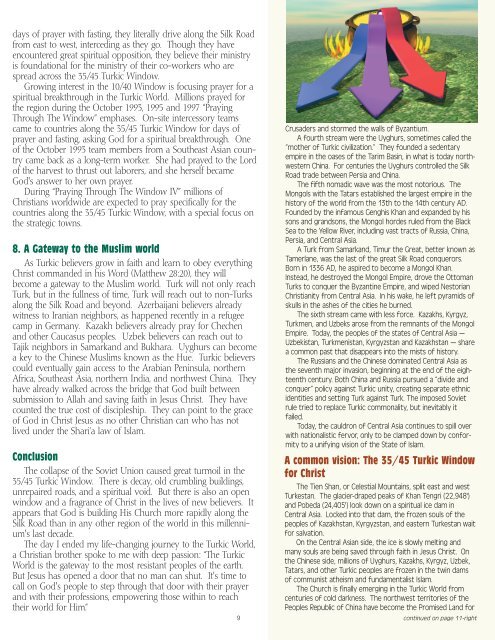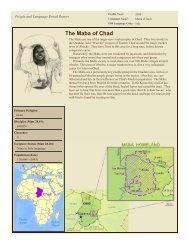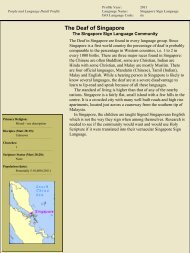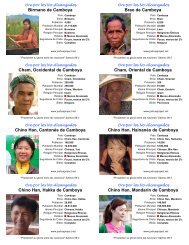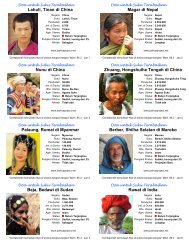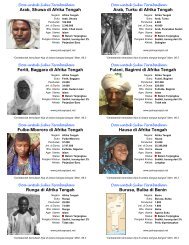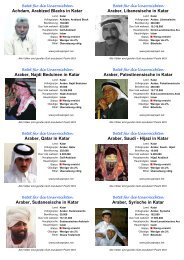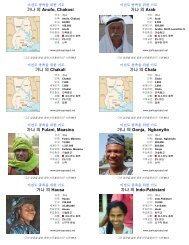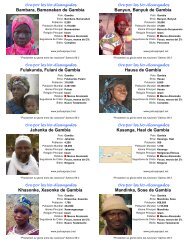AD2000 Turkic Window - Joshua Project
AD2000 Turkic Window - Joshua Project
AD2000 Turkic Window - Joshua Project
Create successful ePaper yourself
Turn your PDF publications into a flip-book with our unique Google optimized e-Paper software.
days of prayer with fasting, they literally drive along the Silk Road<br />
from east to west, interceding as they go. Though they have<br />
encountered great spiritual opposition, they believe their ministry<br />
is foundational for the ministry of their co-workers who are<br />
spread across the 35/45 <strong>Turkic</strong> <strong>Window</strong>.<br />
Growing interest in the 10/40 <strong>Window</strong> is focusing prayer for a<br />
spiritual breakthrough in the <strong>Turkic</strong> World. Millions prayed for<br />
the region during the October 1993, 1995 and 1997 “Praying<br />
Through The <strong>Window</strong>” emphases. On-site intercessory teams<br />
came to countries along the 35/45 <strong>Turkic</strong> <strong>Window</strong> for days of<br />
prayer and fasting, asking God for a spiritual breakthrough. One<br />
of the October 1993 team members from a Southeast Asian country<br />
came back as a long-term worker. She had prayed to the Lord<br />
of the harvest to thrust out laborers, and she herself became<br />
God's answer to her own prayer.<br />
During “Praying Through The <strong>Window</strong> IV” millions of<br />
Christians worldwide are expected to pray specifically for the<br />
countries along the 35/45 <strong>Turkic</strong> <strong>Window</strong>, with a special focus on<br />
the strategic towns.<br />
8. A Gateway to the Muslim world<br />
As <strong>Turkic</strong> believers grow in faith and learn to obey everything<br />
Christ commanded in his Word (Matthew 28:20), they will<br />
become a gateway to the Muslim world. Turk will not only reach<br />
Turk, but in the fullness of time, Turk will reach out to non-Turks<br />
along the Silk Road and beyond. Azerbaijani believers already<br />
witness to Iranian neighbors, as happened recently in a refugee<br />
camp in Germany. Kazakh believers already pray for Chechen<br />
and other Caucasus peoples. Uzbek believers can reach out to<br />
Tajik neighbors in Samarkand and Bukhara. Uyghurs can become<br />
a key to the Chinese Muslims known as the Hue. <strong>Turkic</strong> believers<br />
could eventually gain access to the Arabian Peninsula, northern<br />
Africa, Southeast Asia, northern India, and northwest China. They<br />
have already walked across the bridge that God built between<br />
submission to Allah and saving faith in Jesus Christ. They have<br />
counted the true cost of discipleship. They can point to the grace<br />
of God in Christ Jesus as no other Christian can who has not<br />
lived under the Shari’a law of Islam.<br />
Conclusion<br />
The collapse of the Soviet Union caused great turmoil in the<br />
35/45 <strong>Turkic</strong> <strong>Window</strong>. There is decay, old crumbling buildings,<br />
unrepaired roads, and a spiritual void. But there is also an open<br />
window and a fragrance of Christ in the lives of new believers. It<br />
appears that God is building His Church more rapidly along the<br />
Silk Road than in any other region of the world in this millennium's<br />
last decade.<br />
The day I ended my life-changing journey to the <strong>Turkic</strong> World,<br />
a Christian brother spoke to me with deep passion: “The <strong>Turkic</strong><br />
World is the gateway to the most resistant peoples of the earth.<br />
But Jesus has opened a door that no man can shut. It's time to<br />
call on God's people to step through that door with their prayer<br />
and with their professions, empowering those within to reach<br />
their world for Him.”<br />
9<br />
Crusaders and stormed the walls of Byzantium.<br />
A fourth stream were the Uyghurs, sometimes called the<br />
“mother of <strong>Turkic</strong> civilization.” They founded a sedentary<br />
empire in the oases of the Tarim Basin, in what is today northwestern<br />
China. For centuries the Uyghurs controlled the Silk<br />
Road trade between Persia and China.<br />
The fifth nomadic wave was the most notorious. The<br />
Mongols with the Tatars established the largest empire in the<br />
history of the world from the 13th to the 14th century AD.<br />
Founded by the infamous Genghis Khan and expanded by his<br />
sons and grandsons, the Mongol hordes ruled from the Black<br />
Sea to the Yellow River, including vast tracts of Russia, China,<br />
Persia, and Central Asia.<br />
A Turk from Samarkand, Timur the Great, better known as<br />
Tamerlane, was the last of the great Silk Road conquerors.<br />
Born in 1336 AD, he aspired to become a Mongol Khan.<br />
Instead, he destroyed the Mongol Empire, drove the Ottoman<br />
Turks to conquer the Byzantine Empire, and wiped Nestorian<br />
Christianity from Central Asia. In his wake, he left pyramids of<br />
skulls in the ashes of the cities he burned.<br />
The sixth stream came with less force. Kazakhs, Kyrgyz,<br />
Turkmen, and Uzbeks arose from the remnants of the Mongol<br />
Empire. Today, the peoples of the states of Central Asia —<br />
Uzbekistan, Turkmenistan, Kyrgyzstan and Kazakhstan — share<br />
a common past that disappears into the mists of history.<br />
The Russians and the Chinese dominated Central Asia as<br />
the seventh major invasion, beginning at the end of the eighteenth<br />
century. Both China and Russia pursued a “divide and<br />
conquer” policy against <strong>Turkic</strong> unity, creating separate ethnic<br />
identities and setting Turk against Turk. The imposed Soviet<br />
rule tried to replace <strong>Turkic</strong> commonality, but inevitably it<br />
failed.<br />
Today, the cauldron of Central Asia continues to spill over<br />
with nationalistic fervor, only to be clamped down by conformity<br />
to a unifying vision of the State of Islam.<br />
A common vision: The 35/45 <strong>Turkic</strong> <strong>Window</strong><br />
for Christ<br />
The Tien Shan, or Celestial Mountains, split east and west<br />
Turkestan. The glacier-draped peaks of Khan Tengri (22,948')<br />
and Pobeda (24,405') look down on a spiritual ice dam in<br />
Central Asia. Locked into that dam, the frozen souls of the<br />
peoples of Kazakhstan, Kyrgyzstan, and eastern Turkestan wait<br />
for salvation.<br />
On the Central Asian side, the ice is slowly melting and<br />
many souls are being saved through faith in Jesus Christ. On<br />
the Chinese side, millions of Uyghurs, Kazakhs, Kyrgyz, Uzbek,<br />
Tatars, and other <strong>Turkic</strong> peoples are frozen in the twin dams<br />
of communist atheism and fundamentalist Islam.<br />
The Church is finally emerging in the <strong>Turkic</strong> World from<br />
centuries of cold darkness. The northwest territories of the<br />
Peoples Republic of China have become the Promised Land for<br />
continued on page 11-right


